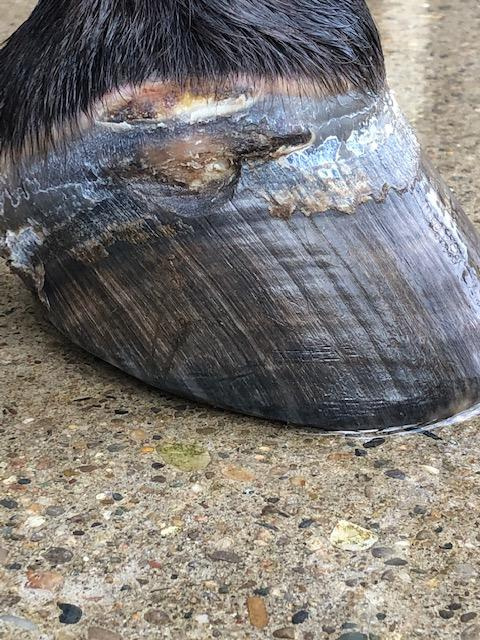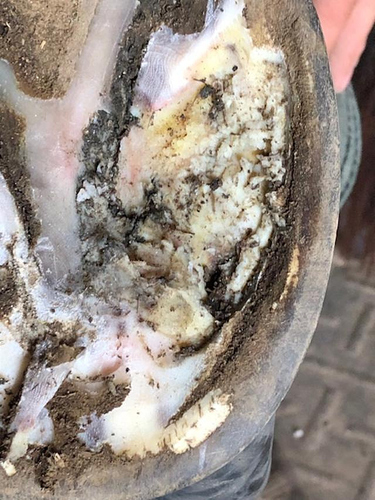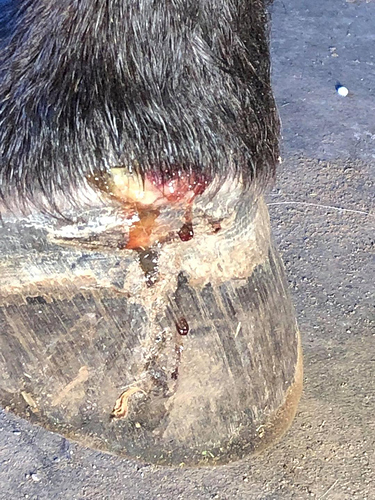I would love any and all ideas for what this might be or what I can do to help this resolve as I am kind of lost at this point
The history:
At the end of September 2024, my horse came up slightly lame left hind, vet visit and x-rays of foot and hock showed nothing but the hoof testers indicated an abscess point by the medial caudal area by the bar and hoof wall. My vet tried to get the abscess to drain with the hoof knife but despite what turned into significant exploration, there was very minimal drainage, like a tiny trickle, and he remained sensitive to the hoof testers in the same spot and still just as lame. We got the standard protocol of soaking with warm water, epsom salts, and betadine, and wrapping with a soaked AnimalIntex pad and changed daily. Also included SMZs 14, 2x a day for 7 days due to mild swelling in the limb. There seemed to be improvement in comfort despite no drainage and there was no hole that needed to be sealed over and I stopped wrapping after two weeks per vets instruction.
A few days out of the wrap and then his leg swelled up and he was SIGNIFICANTLY lame and started to run a bit of a fever (102.4 F) so I had the vet out again. We did more hoof x-rays which showed nothing, he was still reactive to the hoof testers in the same spot. My vet tried to establish drainage again by further hoof knife digging but nothing opened up. Gave him some banamine, started a course of Bute and SMZs, 14 tabs 2x a day for 10 days, and commenced hoof soaking and wrapping again. Fever was gone in a few hours and I continued to monitor temp 2x per day. Comfort did not improve for about 4 days, eventually improved slightly and the lower leg swelling decreased a bit. At this point he was still not putting his heel down at all. About a week in on this round of Bute and SMZs and his temp dropped to 95.4, had a very tucked up abdomen, was very tight in his body, lethargic, not eating/drinking normally, eventually came around in the afternoon and nibbled hay, vet advised continue monitoring and to stop Bute which I did and do two tubes of UlcerGuard over the course of a few days and things improved. Digital pulse still strong in foot.
Beginning of November he was walking better but still trotting lame, reactive to hoof testers, no drainage could be started with hoof knife, blocking the foot did not remove all lameness but slightly improved it. No drainage evident on any poultice pad that I had been wrapping and changing and soaking from the start of this. Slight increase in soreness and swelling around the pastern. On Nov. 8 he developed a significant bump on his coronet band that was sensitive to the touch. I wrapped a warm Animal Intex pad on the bump as part of the wrapping routine and the vet came out a week later. The pad on the bump increased it in size. When the vet came out he was almost 100% sound, no longer reactive to hoof testers. The following week I applied the hoof wrap with the pad on the coronet band, no longer needed to change wrap and could leave the foot bare by Nov 20, applied a topical drawing salve on the lump from that point and stopped using AnimalIntex pads on the lump. Vet came out again Nov 27 to ultrasound the lump and saw nothing, nothing on the ultrasound and nothing on the x-rays. His lameness seems to go on and off, some days looks 100% sound, some days appears a bit sore.
Fast forward, Dec. 16 and the bump opened and appeared to be draining (he did another round of antibiotics as he cut his nose the next day and needed stitches and went on Uniprim for about a week) and since then it has alternated being open and draining and then kind of scabbing over but then opening again. Initially, it was bandaged over but the wrap wasn’t lasting in his turnout, so I was cleaning it with betadine and spraying it with the AluShield aerosol bandage spray. A week ago, I stopped that and have just done nothing to it and let it do its thing. His comfort level continues to ebb and flow, some days he is more comfortable and other days he isn’t. We have the all clear to start riding again but I am not comfortable with that because of how some days he is comfy and others not, so I have been doing 10min hand walks as tolerated the last few days and seeing how that goes before gradually increasing the time.
My vet has said in all his years of practice he has never seen any abscess behave this way. I was thinking that it may be a thing that is in his foot but nothing showing up on X-ray or ultrasound is strange.
If you have come this far, thank you, I feel like I am in a holding pattern and frustrated where it isn’t getting any better and my horse isn’t 100% comfortable/sound and I have no idea where to turn or what to do or if I should keep doing nothing. I know it sounds very human but I feel like there should be something I can do to help him. I had hoped that starting the walking would help expel it more rapidly but I’m not sure its making a difference
I would really value any ideas if anyone has dealt with anything like this, if anyone has any ideas on what I could do to help move this along or any wisdom to share I would really appreciate it. I have attached some pics in chronological order to the best of my ability to show what it looks like for reference.
IMG_5947.HEIC (2.6 MB)
IMG_6045.HEIC (2.3 MB)
IMG_6113.HEIC (2.8 MB)
IMG_6079.HEIC (2.0 MB)
IMG_6166.HEIC (3.2 MB)
IMG_6194.HEIC (2.5 MB)




